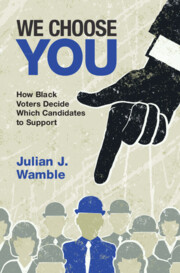Book contents
- We Choose You
- We Choose You
- Copyright page
- Dedication
- Contents
- Figures
- Tables
- Acknowledgments
- Introduction
- 1 The Historical Foundations of Community Commitment
- 2 Community Commitment Signaling Framework
- 3 The Nuances in Black Voters’ Candidate Selection Process
- 4 An Aggregate Test of Community Commitment Signaling
- 5 Community Commitment Signaling and Black Candidate Evaluations
- 6 Community Commitment Signaling and White Candidate Evaluations
- Conclusion
- Appendices
- References
- Index
2 - Community Commitment Signaling Framework
Published online by Cambridge University Press: 06 February 2025
- We Choose You
- We Choose You
- Copyright page
- Dedication
- Contents
- Figures
- Tables
- Acknowledgments
- Introduction
- 1 The Historical Foundations of Community Commitment
- 2 Community Commitment Signaling Framework
- 3 The Nuances in Black Voters’ Candidate Selection Process
- 4 An Aggregate Test of Community Commitment Signaling
- 5 Community Commitment Signaling and Black Candidate Evaluations
- 6 Community Commitment Signaling and White Candidate Evaluations
- Conclusion
- Appendices
- References
- Index
Summary
In this chapter, I introduce and explain my community commitment signaling framework and its inner workings. Despite the strong preference that scholarship explains Black voters have for politicians with roots in the Civil Rights Movement, those politicians are leaving office, making way for a newer crop of representatives. Does this mean the expectations of Black voters have shifted? If they have not, how do these younger politicians communicate that same commitment their predecessors did? I argue that they have to provide evidence of this commitment through the use of signals that convey their willingness to prioritize the group's interest above their own individual prestige. Those politicians who can provide strong, tangible evidence of this commitment are more likely to be viewed positively by Black voters.
- Type
- Chapter
- Information
- We Choose You , pp. 46 - 69Publisher: Cambridge University PressPrint publication year: 2025

